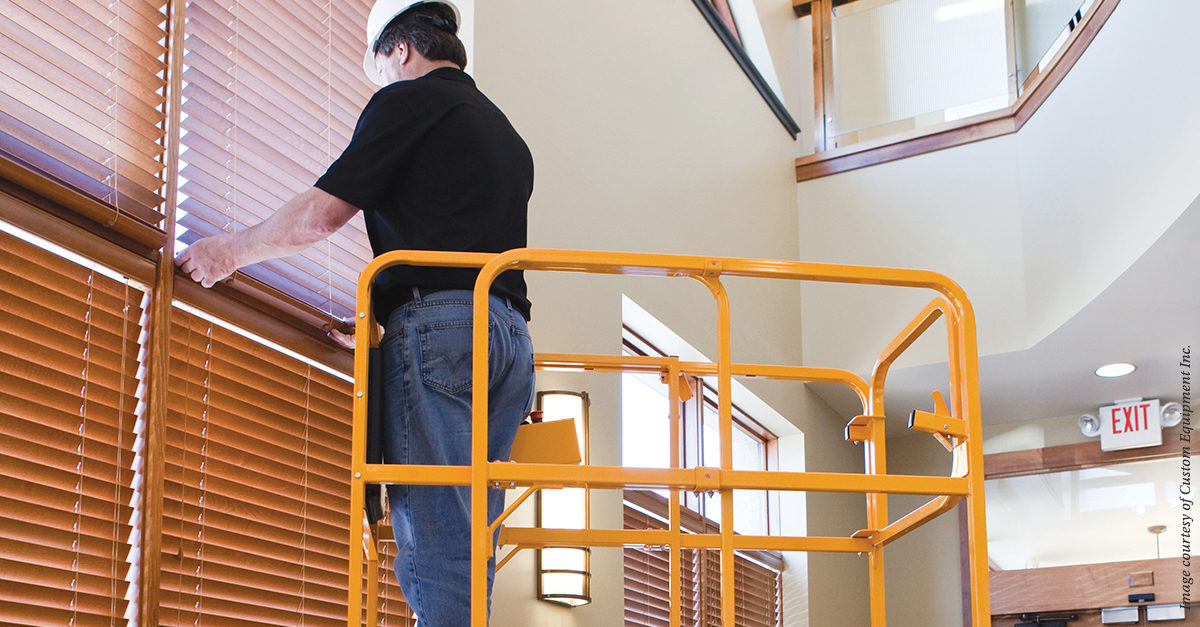Easy. Efficient. Ergonomic. Facility managers and contractors would love to say these three words to describe the equipment their workers use at a busy site. Unfortunately, descriptions for equipment, including ladders and scaffolding, usually involve adjectives such as bulky, time-consuming, and unproductive for the task at hand.
Custodial crews sometimes need to work at heights to complete a range of maintenance projects, from washing windows to repairing roofs or applying a coat of paint. How they reach those working heights can make all the difference for maximizing overall productivity, safety, and potential profits.
Initially managers might consider buying ladders or scaffolding for projects that require working at heights because it seems like a quick fix or an inexpensive option. Ladders and scaffolding can be cost-effective options for small-scale maintenance, such as changing a light bulb or touching up paint, but safety concerns with this equipment can put managers at risk for workers’ compensation claims. For extensive projects, such as ceiling repairs, low-level access lifts are the most efficient and safest alternative.
Move More With Ease
During elevated projects, workers usually come to a point where they can’t reach any farther off a platform to work efficiently; they need to move their equipment to continue or have a platform extension. Adapting to changing work environments determines whether a crew completes a job efficiently; the right piece of equipment is key to adapting.
Since ladders require constant up-and-down movement and scaffolding may require repositioning, it’s worth considering lifts that support a wide range of materials and tools. Aerial lifts easily adapt to changing work environments. These lifts are available in push-around, electrically driven, and hydraulically driven models—each with specific features and benefits that virtually eliminate extra labor associated with ladders and scaffolding.
Pushed or driven lifts: Along with more support, pushed or driven lifts allow for faster movement around the worksite. Some lifts also include slide-out extensions, providing workers up-and-over access for a wide range of obstacles, such as stair railings, which ladders and scaffolding can’t access without putting workers in tough—and sometimes, dangerous—situations.
Lifts that move vertically: Certain aerial lifts also offer a big advantage over ladders and scaffolding by eliminating the extra time and work needed to climb up and down them. The up-and-down movement they provide for loading building materials and reaching the elevated worksite shaves time off maintenance tasks.
Lifts for tight spaces: Some manufacturers offer lifts with a compact footprint that are easy to move through a site. These lifts easily work in tight areas that are typically reserved for ladders or scaffolding, and are narrow enough to fit through doorframes and inside elevators.
Lifts for heavy loads: Ladders and scaffolding require multiple trips and more effort when moving and gathering materials and tools, while lifts can carry most materials needed for the job in one trip. Some low-level lifts support as much as 750 pounds, making them ideal for lifting heavy materials and one or two workers.
Sacrificing Safety Is Risky Business
Recent studies show that falls account for more injuries than almost any other workplace incident. A 2012 report from National Council of Compensation Insurance shows that falls accounted for more than one quarter of worker compensation claims during a 5-year period. For the most recent three years of data available from the U.S. Department of Labor’s Occupational Safety and Health Administration (OSHA), US$93 million was spent each year for falls from ladders and scaffolding for those in carpentry professions alone. Individual claims average $98,000 apiece for medical care and lost wages. Those costs cut profits and can result in expensive downtime. When working at heights, workers on ladders and scaffolding have a high risk for falls from physical factors, such as instability and overexertion.
Safety Solutions
Ergonomic features, such as low step-in heights and full-swing gates, go a long way to minimize worker fatigue, a major contributor to falls. Full-swing gates prevent workers from having to duck under a bar or chain and possibly strain their body. Fewer and lower steps decrease the chance of tripping and falling compared to climbing metal scaffolding or an unstable ladder.
Platform stability is also key to enhancing worker safety for work-at-height projects. Stability contributes to workers’ confidence, helping them work quicker because they feel less likely to fall. Robust scissor stacks and oversized pins provide that stability.
Occasionally, lift manufacturers incorporate features, such as fully enclosed railings and kickboards around the platform, to protect workers above and below. This keeps materials and tools safely inside the platform, preventing any from falling and potentially hitting a worker.
Tips for Scissor Lift Safety
- Only use the lift on a firm level surface. Ensure individuals operating the units have proper training. Be aware of surroundings. Note overhead hazards and ensure all users wear a hardhat to minimize the risk of injuries from overhead objects.
- Be sure the lift is equipped with guardrails that are in solid condition.
- Always stay on the lift platform; never jump onto or climb up guardrails to complete work.
- Set up a “no-go” zone using caution cones to keep bystanders from walking under and around the lift to eliminate the risk of injuries from falling materials.
- Ensure the lift’s components, such as hydraulic hoses and batteries, are in good condition.
- Always follow the manufacturers’ guidelines for proper usage.
Profit With Low-Level Access Lifts
Low-level lifts might not only change managers’ vocabularies regarding how they describe their equipment, but might also mean the difference in terms of productivity and profits down the line.


